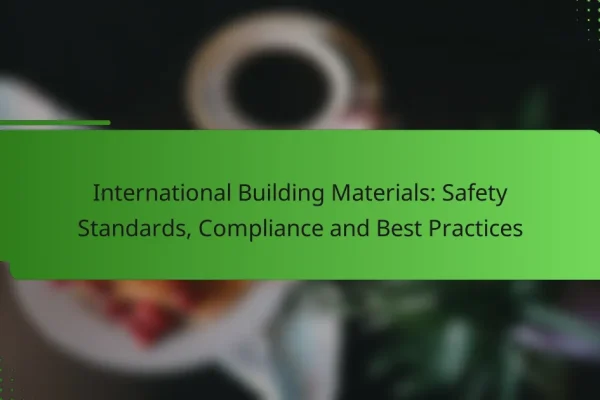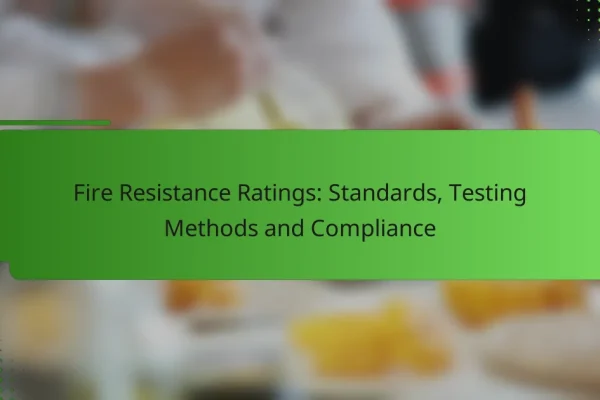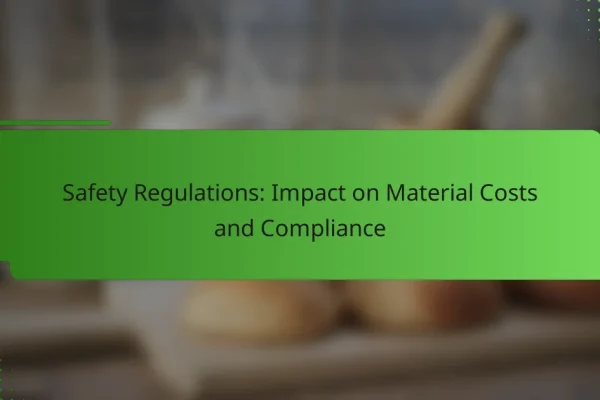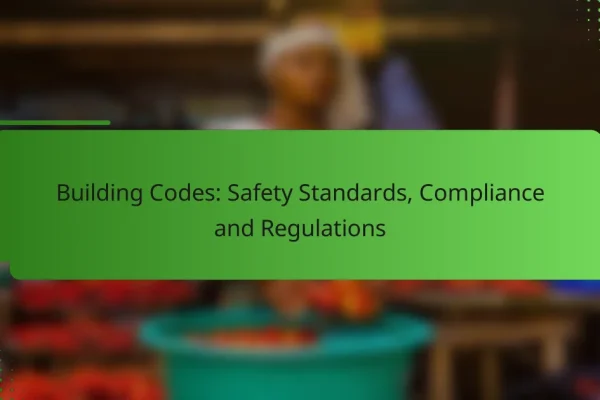What are the key building supplies safety standards in the USA?
The key building supplies safety standards in the USA include regulations and guidelines that ensure the safe use and handling of materials in construction. These standards are essential for protecting workers, promoting safety, and ensuring compliance with legal requirements.
OSHA regulations
The Occupational Safety and Health Administration (OSHA) sets forth regulations that govern workplace safety, including the use of building supplies. These regulations require employers to provide a safe working environment, which includes proper training on the handling of hazardous materials and the use of personal protective equipment (PPE).
Employers must also ensure that building materials meet safety standards and that any potential hazards are communicated to workers. Regular inspections and compliance checks are necessary to maintain adherence to OSHA regulations.
ANSI standards
The American National Standards Institute (ANSI) develops consensus standards that cover a wide range of building supplies and construction practices. ANSI standards focus on ensuring quality and safety in materials, tools, and equipment used in construction.
For example, ANSI standards may dictate the specifications for ladders, scaffolding, and personal protective equipment. Compliance with these standards helps reduce the risk of accidents and injuries on job sites.
ASTM guidelines
The American Society for Testing and Materials (ASTM) provides guidelines that establish testing methods and specifications for building materials. These guidelines help ensure that materials perform as expected under various conditions, contributing to overall safety in construction.
For instance, ASTM standards may cover the fire resistance of materials, structural integrity, and durability. Adhering to ASTM guidelines is crucial for manufacturers and builders to ensure that their products meet safety and performance expectations.
How do building supplies safety standards impact e-commerce?
Building supplies safety standards significantly affect e-commerce by ensuring that products sold online meet specific safety criteria. Compliance with these standards helps retailers avoid legal issues and enhances consumer trust in their products.
Compliance requirements for online retailers
Online retailers must adhere to various compliance requirements to sell building supplies safely. These may include certifications from recognized organizations, adherence to local regulations, and proper labeling of products. For example, in the European Union, products may need CE marking to indicate conformity with health, safety, and environmental protection standards.
Retailers should regularly review their compliance status and stay updated on changes in regulations. Non-compliance can lead to penalties, product recalls, and damage to reputation.
Influence on product listings
Safety standards directly influence how products are listed on e-commerce platforms. Retailers must provide detailed descriptions, including safety features, certifications, and usage instructions. This transparency helps consumers make informed purchasing decisions.
Additionally, compliance can affect search rankings on e-commerce sites. Products that meet safety standards may be prioritized in search results, increasing visibility and sales potential. Retailers should highlight compliance in their product listings to attract safety-conscious buyers.
What are the best practices for ensuring compliance?
Ensuring compliance with building supplies safety standards involves implementing systematic practices that include regular audits and comprehensive training for staff. These measures help identify potential hazards and ensure that all personnel are knowledgeable about safety protocols.
Regular audits
Conducting regular audits is essential for maintaining compliance with safety standards in building supplies. These audits should assess both the physical environment and the processes in place, identifying any areas that may pose risks or fail to meet regulations.
It’s advisable to schedule audits at least quarterly, but more frequent checks may be necessary in high-risk environments. During these audits, ensure that all safety equipment is functioning properly and that materials are stored according to safety guidelines.
Training for staff
Training for staff is a critical component of compliance with safety standards. Employees should receive initial training upon hiring and ongoing education to stay updated on best practices and regulatory changes. This training should cover proper handling of materials, use of safety equipment, and emergency procedures.
Consider implementing a training schedule that includes refresher courses every six months. Additionally, encourage staff to participate in workshops or certifications relevant to building safety to enhance their knowledge and skills.
How do safety standards vary by building supply type?
Safety standards for building supplies differ significantly based on the material type, impacting their use and regulatory compliance. Understanding these variations is crucial for ensuring safety and quality in construction projects.
Wood products standards
Wood products are often governed by standards that focus on structural integrity, moisture content, and treatment processes. For example, the American Wood Protection Association (AWPA) sets guidelines for treated wood to prevent decay and insect damage. Compliance with these standards helps ensure that wood products are safe and durable for construction.
When selecting wood materials, consider the intended use and environmental conditions. For instance, pressure-treated lumber is recommended for outdoor applications, while untreated wood may suffice for indoor uses. Always check for certification marks that indicate compliance with relevant standards.
Metal products standards
Metal products are subject to standards that address corrosion resistance, tensile strength, and fabrication processes. Organizations like the American Society for Testing and Materials (ASTM) provide specifications for various metal types, including steel and aluminum. Adhering to these standards is essential for maintaining structural safety and longevity.
For example, galvanized steel is often used in outdoor applications due to its resistance to rust. When choosing metal supplies, verify that they meet the necessary standards for your specific application, especially in load-bearing structures.
Plastic products standards
Plastic products must meet safety standards related to chemical resistance, fire safety, and environmental impact. The American National Standards Institute (ANSI) and other organizations establish guidelines to ensure that plastic materials are safe for their intended use. These standards help mitigate risks associated with plastic degradation and toxicity.
When selecting plastic building supplies, consider factors such as UV resistance and temperature tolerance. For instance, PVC is commonly used for plumbing due to its durability and resistance to corrosion. Always check for certifications that confirm compliance with relevant safety standards.
What are the consequences of non-compliance?
Non-compliance with building supplies safety standards can lead to serious repercussions, including legal penalties and significant financial losses. Organizations must adhere to these regulations to avoid detrimental outcomes that can impact their operations and reputation.
Legal penalties
Failure to comply with safety standards can result in legal penalties, which may include fines, sanctions, or even criminal charges. Regulatory bodies enforce these standards rigorously, and violations can lead to lawsuits or the revocation of licenses necessary for operation.
For example, companies in the construction industry may face fines ranging from thousands to millions of dollars depending on the severity of the violation. Additionally, repeated offenses can escalate penalties and lead to stricter oversight.
Financial losses
Financial losses due to non-compliance can manifest in various ways, including increased insurance premiums, costs associated with product recalls, and potential loss of business. Companies may also incur expenses related to legal fees and settlements if they are sued for non-compliance.
Moreover, non-compliance can damage a company’s reputation, leading to decreased customer trust and loss of market share. In some cases, businesses may see a drop in sales by tens of percent if consumers perceive them as unsafe or unreliable.
What are the emerging trends in building supplies safety?
Emerging trends in building supplies safety focus on integrating advanced technology, promoting sustainability, and achieving global harmonization of standards. These trends aim to enhance safety protocols and ensure compliance with evolving regulations.
Increased use of technology
The integration of technology in building supplies safety is transforming how materials are tested and monitored. Tools such as IoT sensors and AI-driven analytics help track the condition of supplies in real-time, identifying potential hazards before they escalate.
For instance, smart sensors can detect moisture levels in wood, alerting builders to potential rot or mold issues. This proactive approach minimizes risks and ensures safer construction practices.
Focus on sustainability
Sustainability is becoming a key focus in building supplies safety, with an emphasis on eco-friendly materials and practices. Builders are increasingly opting for recycled or sustainably sourced materials that meet safety standards while reducing environmental impact.
Using sustainable materials not only enhances safety but also aligns with regulations in many regions that promote green building practices. For example, materials certified by recognized organizations often meet higher safety benchmarks.
Global harmonization of standards
Global harmonization of safety standards is essential for ensuring consistent quality and safety across borders. Organizations like ISO are working to align safety regulations, making it easier for manufacturers and builders to comply with international requirements.
This harmonization helps reduce confusion and enhances safety by ensuring that building supplies meet universally accepted criteria. As a result, builders can confidently source materials from different countries, knowing they adhere to the same safety standards.
How can businesses prepare for future safety regulations?
Businesses can prepare for future safety regulations by staying informed about industry standards and implementing proactive safety measures. This involves regular training, updating safety protocols, and engaging with regulatory bodies to anticipate changes.
Stay Informed About Regulations
Regularly monitor updates from relevant regulatory agencies to ensure compliance with safety standards. This can include subscribing to newsletters, attending industry conferences, or joining professional organizations that focus on safety regulations.
Consider establishing a dedicated team or appointing a safety officer responsible for tracking regulatory changes. This team can provide insights and updates to the rest of the organization, ensuring everyone is aware of their responsibilities.
Implement Regular Training Programs
Conduct regular training sessions for employees to familiarize them with safety protocols and new regulations. Training should cover the proper use of equipment, emergency procedures, and hazard recognition.
Utilize a mix of training methods, such as hands-on demonstrations, online courses, and workshops, to accommodate different learning styles. Regular refresher courses can help reinforce safety practices and keep employees engaged.
Conduct Safety Audits
Perform routine safety audits to identify potential hazards and areas for improvement. These audits should assess compliance with existing regulations and evaluate the effectiveness of current safety measures.
Involve employees in the audit process to gain insights from those directly working with the materials and equipment. This collaborative approach can lead to more comprehensive safety improvements and foster a culture of safety within the organization.
Engage with Regulatory Bodies
Establish relationships with local regulatory bodies to gain insights into upcoming changes in safety standards. This proactive engagement can help businesses prepare for new regulations before they are enforced.
Participate in public consultations or forums hosted by regulatory agencies to voice concerns and contribute to the development of safety standards. This involvement can also enhance a company’s reputation as a responsible and safety-conscious organization.












